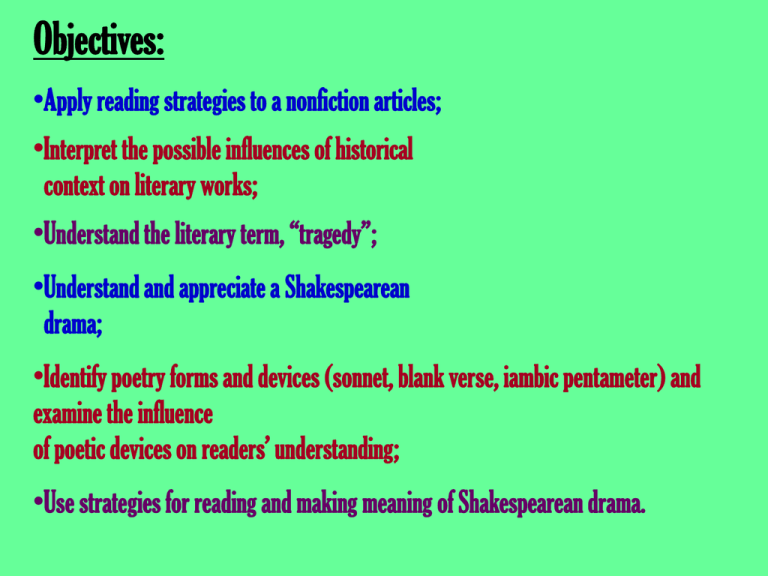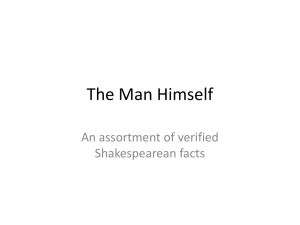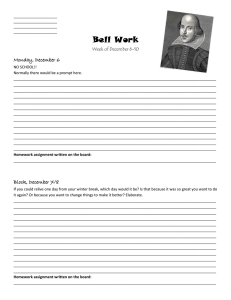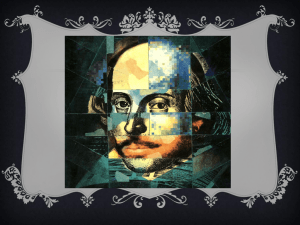Shakespeare's World for Romeo and Juliet
advertisement

Objectives: •Apply reading strategies to a nonfiction articles; •Interpret the possible influences of historical context on literary works; •Understand the literary term, “tragedy”; •Understand and appreciate a Shakespearean drama; •Identify poetry forms and devices (sonnet, blank verse, iambic pentameter) and examine the influence of poetic devices on readers’ understanding; •Use strategies for reading and making meaning of Shakespearean drama. Background for Understanding Romeo and Juliet: FOCUS •Write for 2-3 minutes responding to the question, “Why study Shakespeare?” •Read: “Shakespeare’s Impact on the English Language,” page 985. SHAKESPEARE’S WORLD Why study Shakespeare? •Considered the greatest writer in the English language •He contributed more words, phrases, and expressions to the English language than any other writer. • “Cultural literacy and refinement”: appreciate the sheer beauty of his language and art. •Wrote from 1558 – 1603 •Lived in England period known as the Renaissance. •Renaissance: period marked by renewed interest in science, philosophy, and the arts. •“intEllEctuAl flowERing” •Wrote during the • reign of Queen Elizabeth I. • “ElizAbEtHAn AgE” Elizabeth I •Last member of royal house of Tudor. •Father was Henry VIII •Tudors brought stability and prosperity to England. • Elizabeth was a strong ruler. •Supported the arts in English culture. •Shakespeare benefited from ElizAbEtH’S encouragement of artistic development. •in 1590’S HE bEgAn acting in and writing plays for a theater company owned by two highranking men in ElizAbEtH’S couRt. •Elizabeth attended SomE of SHAKESPEARE’S productions. Terms for Understanding the Drama: Prologue an introductory section of a play, speech, or other literary work Terms for Understanding the Drama: Tragedy A drama that ends in catastrophe—most often in death—for the main character and often for several other characters as well. CHARACTERISTIC OF TRAGEDY Tragic hero: the main character in a tragedy, who comes to an unhappy or miserable end. Tragic flaw: a fatal error in judgment or weakness of character, that leads directly to the protagonist’s downfall. Comic Relief A humorous scene, incident, or speech that relieves the overall emotional intensity. Pun: an expression that achieves emphasis or humor by contriving an ambiguity, two distinct meanings suggested by the same word. Example: When you've seen one shopping center you've seen a mall. A bicycle can't stand alone because it is two-tired. Marathon runners with bad footwear suffer the agony of defeat. The man who fell into an upholstery machine is fully recovered. When an actress saw her first strands of gray hair she thought she'd dye. FOIL Benvolio Tybalt A character whose personality or attitudes are in sharp contrast to another character Oxymoron: an expression in which two words that contradict each other are joined Allusion: a reference To a historical or fictional person, place, or event with which the reader is assumed to be familiar. ASIDE: a character’s remark, either to the audience or to another character, that the other characters on stage are not supposed to hear. Purpose: reveals character’s thoughts. MOTIF: A conspicuous recurring element, such as a type of incident, a device, a reference, or verbal formula, which appears frequently in works of literature. - a pattern Monologue: an extended speech by one speaker. Dramatic Monologue: a lyric poem in which a speaker addresses a silent or absent audience in a moment of high emotion. Soliloquy A speech that a character gives when he or she is alone on stage. The purpose is to let the audience know what the character is thinking Theme: a central idea or message in a work of literature; generally makes a comment on life or the human experience Themes tend to be universal, that is, the messages they convey applies to all people, in all ages and places. Theme concepts in Macbeth • False appearances - acting - lies - deception - equivocation (hedging) • Evil - a force beyond human understanding - developed through plant imagery • Treachery • Murder • Political rebellion • Revenge - Developed through disease images • Consequences of choices / actions • Guilt • Ambition - as it erodes / overcomes moral principles Imagery: words and phrases that create vivid sensory experiences for the reader. Motifs in Macbeth • BLOOD--obviously everywhere, but note how it foreshadows the deaths, morally, psychologically and mentally, of the protagonists. •SLEEP--this is a major theme: What does Macbeth mean when he fears murdering sleep; who sleeps for him, and why can he "sleep no more?" • Images of the theater and banquet imagery • CLOTHING as in "borrowed robes" • DARKNESS - symbolizes the darkness in Macbeth’s heart? Symbol: a person, place, object, or activity that stands for something beyond itself. Mood: the feeling or atmosphere that a writer creates for a reader. - created by diction, imagery, setting, foreshadowing, dialogue, figurative language Dramatic irony: occurs when the reader or audience knows something that the character does not. Blank verse: unrhymed poetry written in iambic pentameter Meter: The repetition of a regular rhythmic unit in poetry. Each meter is known as a foot, consisting of one stressed syllable and one or two unstressed syllables. The meter of a poem emphasizes the musical quality of the language. Iambic pentameter: pattern of an unstressed syllable followed by a stressed syllable. Anachronism: Someone or something belonging to another time period than the one in which it is described as being. The reference, in Shakespeare's Julius Caesar, to "the clock striking twelve" is anachronistic, since there were no striking timepieces in ancient Rome. The Great Chain of Being The purpose of the Great Chain of Being was to assign a place for everything in the universe, classified into either: •Holy •Animal •Vegetable •Mineral Example: If one were to examine only the earthly inhabitants, and their place in the chain, this is what would be found: •Perfection (God) •Angels •Humans •Beasts •Plants •Rocks The concept of "animal, vegetable, and mineral" still survives and is a feature of many Western philosophies and cultures to this day. The Great Chain of Being God Angels Kings/Queens Archbishops Dukes/Duchesses Bishops Marquises/Marchionesses Earls/Countesses Viscounts/Viscountesses Barons/Baronesses Abbots/Deacons Knights/Local Officials Ladies-in-Waiting Priests/Monks Squires Pages Messengers Merchants/Shopkeepers Tradesmen Yeomen Farmers Soldiers/Town Watch Household Servants Tennant Farmers Shepherds/Herders Beggars Actors Thieves/Pirates Gypsies Animals Birds Worms Plants Rocks •For Catholics, the Pope is at the same level or above the King. England in SHAKESPEARE’S dAy Background for Understanding Romeo and Juliet: FOCUS I •Page 983-984 •With a partner, read from the nonfiction article “Shakespeare’s World: England in Shakespeare’s Day.” •STOP just before “Theater in Shakespeare’s Day” section. •Bullet notes: Together, summarize what you feel are the 5 most important details from “England in Shakespeare’s Day” (7 minutes for the above) •Be prepared to share out your ideas orally.







